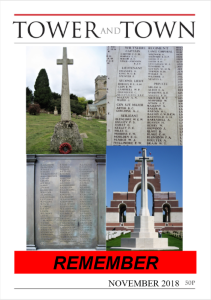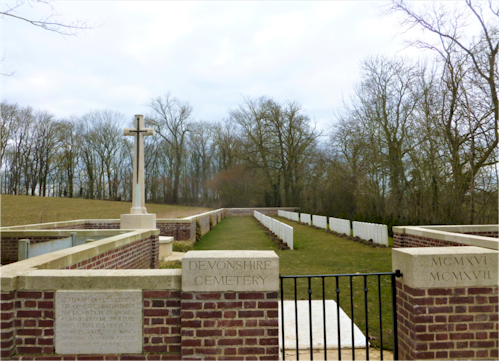

Tower and Town, November 2018 (view the full edition) (view the full edition)The Western Front TodayNearly all the action of the war took place along the Western Front which runs North/South from the North Sea in Belgium to the Swiss border. This is where the combatants fought and were buried in hundreds of cemeteries and where the great memorial monuments, designed by famous architects, were built; all of which are today visited by thousands of people from all over the world. I was one of those visitors in 2014 at the beginning of the great centennial commemorations. Such was the censorship that it was only in letters home from the Front that a few people at home learnt of the appalling conditions their kinsmen were suffering under. The public can now walk through some of the preserved trenches and see for themselves the underground bunkers in which men lived and died in the cold, the wet and the horrendous mud. The now rusty barbed wire defences are still there, the surrounding fields still throw up the occasional body parts and uniforms of those that fell and were never found. The knowledge of their sacrifice is kept alive by the local community, the Commonwealth War Graves Commission, and the vast numbers of visitors, especially schoolchildren, who find many of those who lost their lives fighting for our futures were of similar ages to themselves. I was awed by the beauty of the cemeteries we visited: small ones, like the clearing amongst trees where one hundred and sixty-three members of the Devonshire Regiment were buried in what had been their front-line trench ("The Devonshires held this trench; the Devonshires hold it still"); huge ones, like the Tyne Cot cemetery where just short of twelve thousand men are buried. On a visit to what is the largest Commonwealth War Graves Commission cemetery in the world in 1922, King George V said: We can truly say that the whole circuit of the Earth is girded with the graves of our dead .... I have many times asked myself whether there can be more potent advocates of peace upon Earth through years to come than this massed multitude of silent witnesses to the desolation of war.  Men from the same regiments lie next to each other, in death as in life, brothers in arms whose patriotism, sense of duty and friendships inspired them to give up so much for us. A highlight for me was being present at the daily Menin Gate ceremony along with thousands of others from across the Commonwealth, where it was possible to remember with respect the sacrifice of so many one hundred years ago. The bugles sound The Last Post, those memorable words from Laurence Binyon's poem For The Fallen are spoken, and then after a minute's silence and before Reveille is played, the lines of the Kohima Epitaph ring out as if from the mouths of the dead: "When you go home, tell them of us and say, for their tomorrow, we gave our today." Jane Nicholson |